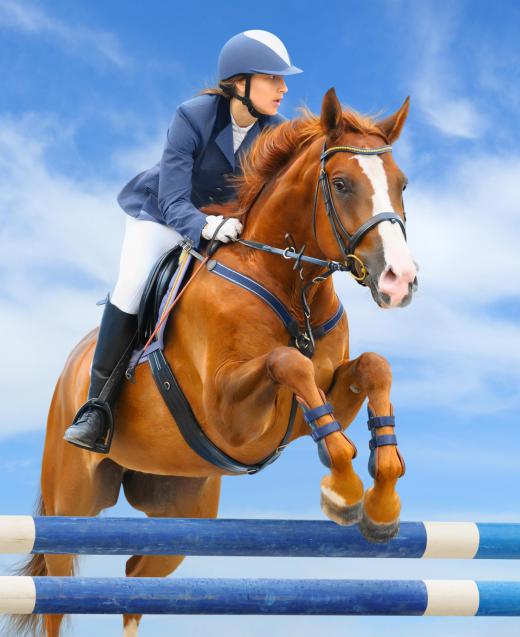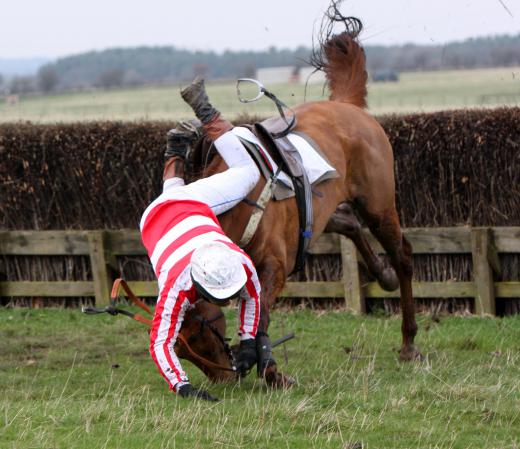Steeplechase horse racing is a type of sporting event in which horses and their riders scale a number of obstacles in the fastest possible time. It gets its name from the early Irish races that were the precursor to modern events; back in the 1800s, riders in that country would routinely race from church to church — or steeple to steeple — crossing every creek, fence, and fallen tree along the way. Most modern races aren’t on open courses the way they were then, and the obstacles are usually fixed and are the same for all contestants. There are a couple of variations on this sort of race that depend at least in part of location, though. Different countries have different traditions when it comes to the sort of obstacles that are used as well as whether racers actually compete against each other on the course or whether they are competing individually against a clock. This style of racing in all its forms is most popular in Ireland and the UK, the US and Canada, and Australia, and in all places riders usually spend a lot of time training their horses and coaching them to jump in a precise and efficient way.
Origins and History

Steeplechase horse racing began in Ireland, with the first recorded steeplechase occurring in County Cork in 1752. Since church steeples were the tallest and most prominent landmarks, they were used to mark the finish line for the course; hence, the term steeplechase evolved from the simple idea of a "chase to the steeple" or possibly the idea of actually chasing the steeple itself. In Ireland at that time, each village or town typically had its own church, the steeples of which were usually visible over the land despite often rough terrain and great distances. Racing from church to church was a popular pastime and venue for gambling among onlookers and participants both.

It’s widely believed that the sport evolved from the European pastime of fox hunting, and gave hunters a way to test the speed of their mounts during a cross-country chase. The first steeplechase courses were often over rough terrain, which meant that horse and rider were forced to deal with whatever unforeseen obstacles might be in their path. The main goal was to get to the steeple first. In order to do this, both horse and rider had to be very skilled and able to jump, wade water, and cleverly maneuver their way to the finish line. Needless to say, it was a difficult and dangerous proposition.
Modern Races

As the sport progressed, the basic steeplechase course evolved into a pre-determined route, with reasonable and measured obstacles and a set length. The first organized steeplechase racing began around 1830, and a basic steeplechase course today is usually somewhere between 2 and 4 miles (3.2 to 6.4 km) long and consists of a combination of obstacles such as stone walls, water jumps, brush fences, and timber rails.
Steeplechase horse racing spread from Ireland and England to most other countries, but is usually the most popular in the US, Canada, and Australia. Big races happen in each of these countries every year, though the most popular and the best attended is usually England’s annual Grand National race at Aintree, in Liverpool.
Geographical Variations
Different countries have different specific definitions for what a steeplechase course looks like and how the race is organized. In the US, it’s common for any race involving obstacles to be called a “steeplechase,” for instance, though in the UK there is often a difference between a steeplechase and a more standard “jump race.” A lot of this has to do with the height of the jumps, what they’re made of, and whether they are fixed or portable. Depending on the course and the race specifics, horses usually compete all together; this is most traditional and is usually preferable. In some cases, though, they might also compete individually and vie for the best clock time.
Training and Preparation
Getting horses ready to compete in a steeplechase race is often a long and involved undertaking. Riders, often known as “jockeys,” usually spend a lot of time working with the animals on ways to clear jumps and traverse hurdles without losing their stride or speed.
A form of steeplechase racing known as hurdling is often used to train horses for more strenuous courses. The obstacles usually consist of hurdles that are 1 to 2 ft (0.3 to 0.6 m) lower than the obstacles that are likely to be encountered on race day, and these training courses are usually less than 2 miles (3.2 km) in length.
